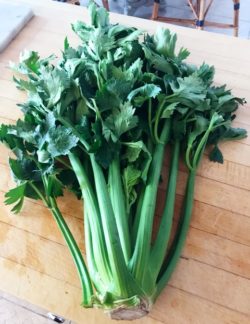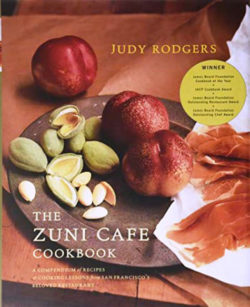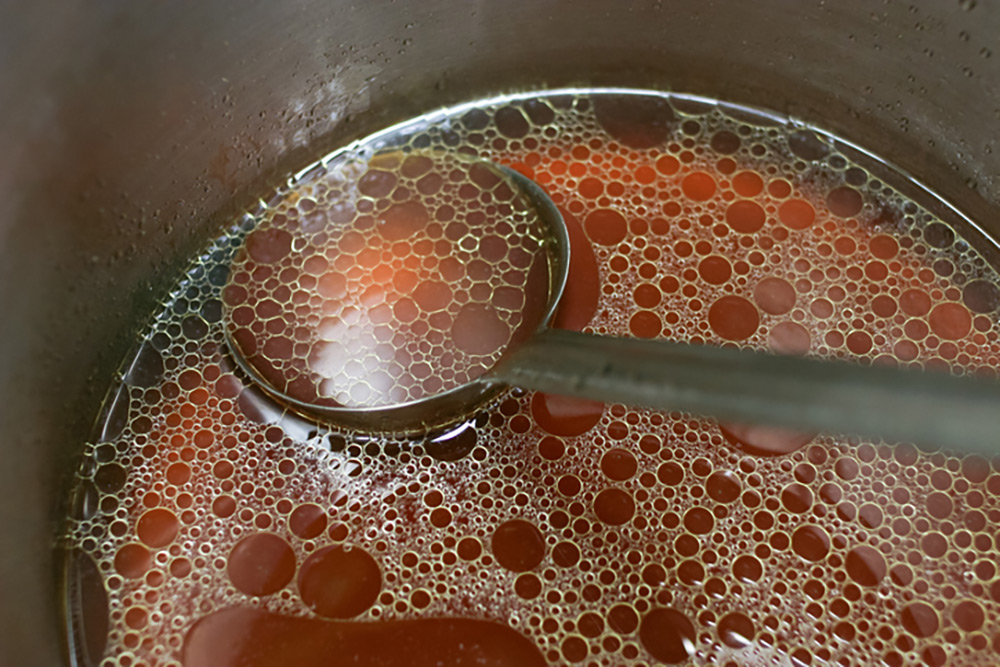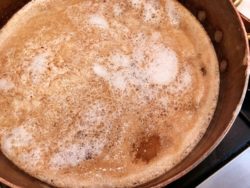After owning one of the best cooking stores in the US for 47 years—La Cuisine: the Cook’s Resource, in Alexandria, Virginia—Nancy Pollard now writes Kitchen Detail, a blog about food in all its aspects—recipes, film, books, travel, superior sources and food-related issues. She and her husband, the Resident Wine Maniac, have recently moved to Italy.

Eastern gray squirrel from www.aces.edu.

Hardy-looking fresh celery in the KD kitchen. / Photo by Nancy Pollard.
I’M LOOKING AT the squirrels on my kitchen window boxes, barreling through my newly planted parsley. These cute little varmints, forever immortalized by Beatrix Potter, replace all my winter planting efforts with their stashes of nuts. I have been accused of doing the same thing in our freezer. I save the ends of tomatoes to make passata in the summer, and, throughout the year, I save beef, veal and lamb bones to make an annual cache of mixed brown stock. A couple of years ago I was reminded by someone in this house that stock-making time had come as a frozen bag of bones came tumbling out of the freezer onto his foot.
(As a side note, in case you have not seen it, I offer for your viewing hilarity a now famous squirrel video from Mark Rober…and there are sequels).
Fortunately, I had times the project that year with the fall arrival of fresh celery from Twin Springs Fruit Farm, of Orrtanna, Pennsylvania, and could use the leaves in the stock pot along with a small branch of bay leaves from my long-suffering bay bush, very tired carrots from the crisper, and onion leavings (also in the freezer).
In the Beginning
 The guide on making stocks from Judy Rodgers in her Zuni Café Cookbook is very helpful, though I don’t follow her detailed pages of advice religiously. In fact, this cookbook is one I return to often for techniques and recipes. Don’t let your stock boil, don’t leave on for more than a few hours, and taste it until you are happy with the flavor. The Zuni Café kitchen apparently does not stockpile bones from rib roasts, veal, and lamb chops and steaks in the freezer; rather they make their stocks from fresh meats and bones. But with the price of sustainably grown proteins, I feel that it is necessary to wring out every molecule of flavor from leftover bones. That said, I do follow her advice on salting early: Doing it after clarification gives the stock an unsettled salty flavor. I found this out the hard way after I was advised in another highly recommended book that one should salt the stock after the initial simmering and reduction. Not good advice. Rodgers also says not to skim the fat off while your stock is simmering, as the fat actually helps to give it a deeper flavor. As soon as you are happy with the taste, turn off the heat and proceed to the ncxt step.
The guide on making stocks from Judy Rodgers in her Zuni Café Cookbook is very helpful, though I don’t follow her detailed pages of advice religiously. In fact, this cookbook is one I return to often for techniques and recipes. Don’t let your stock boil, don’t leave on for more than a few hours, and taste it until you are happy with the flavor. The Zuni Café kitchen apparently does not stockpile bones from rib roasts, veal, and lamb chops and steaks in the freezer; rather they make their stocks from fresh meats and bones. But with the price of sustainably grown proteins, I feel that it is necessary to wring out every molecule of flavor from leftover bones. That said, I do follow her advice on salting early: Doing it after clarification gives the stock an unsettled salty flavor. I found this out the hard way after I was advised in another highly recommended book that one should salt the stock after the initial simmering and reduction. Not good advice. Rodgers also says not to skim the fat off while your stock is simmering, as the fat actually helps to give it a deeper flavor. As soon as you are happy with the taste, turn off the heat and proceed to the ncxt step.
At this point, do not wait for the stock to cool, but instead remove the bones and vegetal debris by pouring the stock into a bowl through a fine sieve or towel in a colander. Mine fills a large bowl (the one I make my mother-in-law’s fruitcake in) and let it sit in the refrigerator until the fat and flotsam congeal at the top. This gets scraped off before putting the liquid in a large pan in which you are going to clarify the muddy-looking stock. In a separate bowl, put two egg whites for every quart of stock you have measured out; you can add a bit of water and lemon juice if that helps you to break them up, as shown in the video, below. Add some lightly crushed egg shells if you have them and mix them until the egg mixture is just barely frothy. Fold this into the cold stock; it’s fine if the stock has gelled because the whites will fold into the stock whether it is cold liquid or has solidified.
The Grand Finale

Here is the stock before, right, and after clarification in the KD kitchen. / Photo by Nancy Pollard.
Over medium-low heat, allow the stock to simmer. Do not ever allow it to come to a boil. You will see the egg white “raft” developing (see left). At some point, within 20 minutes or a bit longer if you are doing a large amount, you may get a little peephole in your raft. If not, make a small one so you can see the progress. I love this part! Once you see that the small area is clear, you can ladle or pour the stock out, this time through a sieve lined with moistened cheese cloth or towel. (My favorite cheesecloth is this organic version, which I use repeatedly. It washes easily.) You can see in the two glasses, above right, that my stock was much cloudier than the one in the video below, because I had so many vegetables in the mix.
Freeze your stock in bags or containers and mark the date. I store mine in freezer bags in about two-cup increments. Recycled glass jars or plastic containers (both with tight-fitting lids) are fine too, but leave a good two inches of head space. You are now ready to make all sorts of consommés with local mushrooms, for example, or Asian-style soups with small strips of chicken, seafood, beef or pork, and additional vegetables. This stock makes a divine winter risotto with radicchio and red wine or it can be used to create a delicious sauce. The only thing it does not work for is a dessert.




I totally understand. I look at knitting , which I used to do, in the same way!
I like reading about all these complicated kitchen endeavors. However, if I’ll never use it or eat it or cook with it, it’s purely entertaining reading for me. But I certainly admire people who actually do this! Thank you.